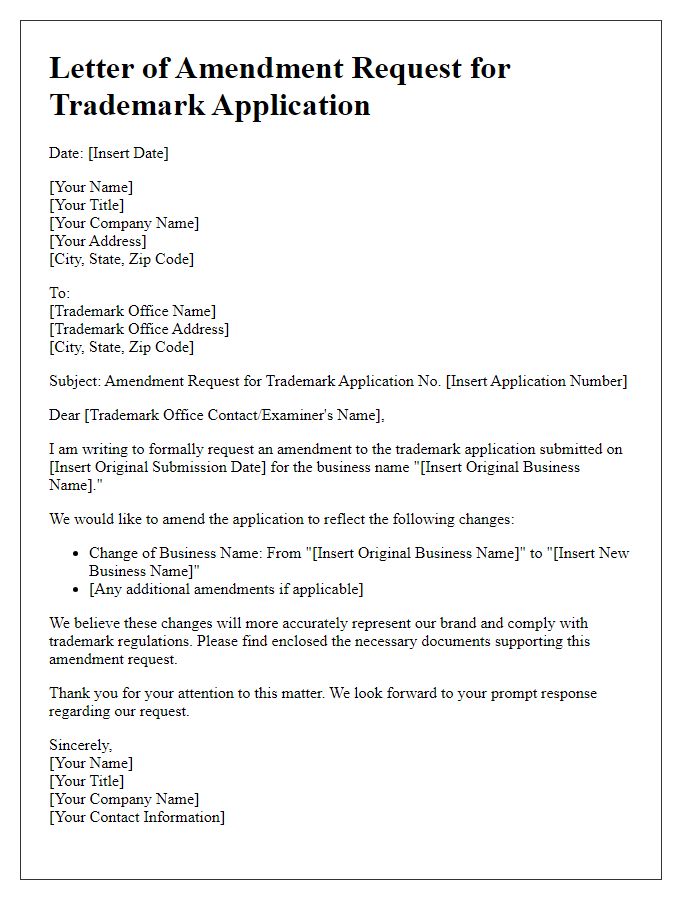Are you considering protecting your brand with a trademark? Navigating the trademark application process can be daunting, but it's essential for securing your business identity. In this article, we'll walk you through a helpful letter template that simplifies the trademark application for your business name. So, grab a cup of coffee and read on to ensure your brand's protection!

Trademark search results
A trademark search reveals the status of various trademarks pertinent to your business name aspirations. Within the United States Patent and Trademark Office (USPTO) database, similarities in existing trademarks, such as "EcoFriendly Products" or "Smart Tech Solutions," were identified. These trademarks, registered under Classes 25 and 9 respectively, may pose challenges when submitting a new trademark application. Understanding potential conflicts with already established entities will be crucial, particularly given the increasing emphasis on brand differentiation in competitive markets. Additionally, state trademark registrations may further influence the naming strategy and legal considerations involved in trademark pursuit.
Specific goods/services description
When applying for a business name trademark, a detailed description of specific goods and services is essential. A comprehensive description should clearly identify the types of products or services your business offers. For instance, if your trademark is associated with a line of organic skincare products, include terms such as "natural moisturizers," "herbal face masks," or "sunscreens with SPF 30." Specify the intended audience, such as "products targeted at environmentally-conscious consumers." If applicable, mention any unique features, such as "vegan formulations" or "cruelty-free testing," to distinguish your goods. If services are involved, illustrate their nature; for example, if offering educational workshops, define them as "interactive skincare education sessions for beauty professionals." Ensuring your description clearly outlines all aspects of your offerings increases the likelihood of a successful trademark registration.
Applicant's legal information
Legal information related to trademark application includes vital components, such as the applicant's full legal name (individual or business entity), the business type (corporation, LLC, partnership), and the principal place of business (physical address). Additionally, the applicant should provide the state of incorporation or registration (for example, Delaware, California) to confirm the legal status. Contact information (such as email and phone number) is crucial for communication purposes. Furthermore, the description of the goods or services associated with the trademark should be clearly stated, adhering to the classifications set by the United States Patent and Trademark Office (USPTO) or relevant national authority. Detailed records enhance legal protection and facilitate a smoother registration process.
Trademark representation or logo
A trademark application for a business name, such as a New York-based tech startup, requires a detailed representation of the trademark. The trademark should be clearly defined, including specific colors, shapes, and font styles used in the logo design. The application must also include a visual representation of the logo, formatted to meet the United States Patent and Trademark Office (USPTO) guidelines. This representation should illustrate how the logo appears in different contexts, such as digital platforms and printed materials, to ensure comprehensive coverage. Additionally, the application must specify the intended goods or services associated with the trademark, like software development or mobile applications, to establish the connection between the business name and its offerings in the technology market. Proper classification under the International Nice Classification (Class 9 for software) is crucial for successful registration.
Signed declaration statement
A signed declaration statement for a business name trademark application serves as a legal affirmation by the applicant regarding the authenticity of the submitted information. This document typically includes essential details, such as the applicant's name, business entity type (e.g., corporation, LLC, partnership), and the specific trademark (name) being registered. Additionally, the statement confirms that the applicant has a bona fide intention to use the trademark in commerce, and it asserts that there is no known conflict with existing trademarks, thereby ensuring legal compliance. Moreover, applicants may include their address and contact information to facilitate communication during the registration process, highlighting their commitment to following trademark laws, specifically the Lanham Act, and confirming that the trademark is not deceptively descriptive or functional.
Letter Template For Business Name Trademark Application Samples
Letter template of intent to apply for business name trademark registration

Letter template of authorization for business name trademark representation

Letter template of objection response for business name trademark application

Letter template of amendment request for business name trademark application










Comments